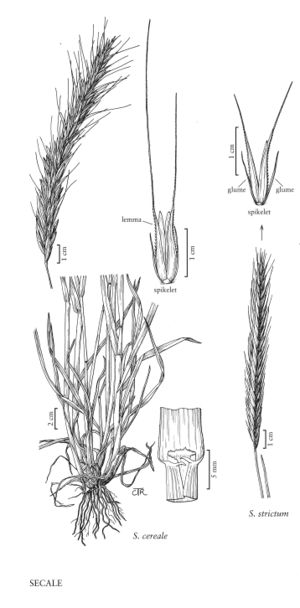Difference between revisions of "Secale cereale"
FNA>Volume Importer |
FNA>Volume Importer |
||
| Line 17: | Line 17: | ||
-->{{Treatment/Body | -->{{Treatment/Body | ||
|distribution=Conn.;N.J.;N.Y.;Wash.;D.C;Wis.;Mass.;Maine;N.H.;R.I.;Vt.;Fla.;Wyo.;N.Mex.;Tex.;La.;N.Dak.;Nebr.;Tenn.;N.C.;S.C.;Pa.;Alaska;Nev.;Va.;Colo.;Md.;Calif.;Ala.;Ark.;Ill.;Ga.;Ind.;Iowa;Ariz.;Idaho;Mont.;Oreg.;Ohio;Utah;Mo.;Minn.;Mich.;Kans.;Miss.;Ky.;Alta.;B.C.;Greenland;Man.;N.B.;Nfld. And Labr. (Labr.);N.S.;N.W.T.;Ont.;P.E.I.;Que.;Sask.;Yukon;S.Dak. | |distribution=Conn.;N.J.;N.Y.;Wash.;D.C;Wis.;Mass.;Maine;N.H.;R.I.;Vt.;Fla.;Wyo.;N.Mex.;Tex.;La.;N.Dak.;Nebr.;Tenn.;N.C.;S.C.;Pa.;Alaska;Nev.;Va.;Colo.;Md.;Calif.;Ala.;Ark.;Ill.;Ga.;Ind.;Iowa;Ariz.;Idaho;Mont.;Oreg.;Ohio;Utah;Mo.;Minn.;Mich.;Kans.;Miss.;Ky.;Alta.;B.C.;Greenland;Man.;N.B.;Nfld. And Labr. (Labr.);N.S.;N.W.T.;Ont.;P.E.I.;Que.;Sask.;Yukon;S.Dak. | ||
| − | |discussion=<p>Secale cereale is one of the world's most important cereal grasses; it is also widely used in North America for soil stabilization and, particularly in Canada, for whisky. When dry, the spike is often distinctly nodding. Frederiksen and Petersen (1998) placed cultivated plants with a non-disarticulating rachis into Secale cereale L. subsp. cereale, and wild or weedy plants with more fragile rachises into S. cereale subsp. ancestrale Zhuk.</p> | + | |discussion=<p><i>Secale cereale</i> is one of the world's most important cereal grasses; it is also widely used in North America for soil stabilization and, particularly in Canada, for whisky. When dry, the spike is often distinctly nodding. Frederiksen and Petersen (1998) placed cultivated plants with a non-disarticulating rachis into <i>Secale cereale</i> L. subsp. cereale, and wild or weedy plants with more fragile rachises into <i>S. cereale</i> subsp. ancestrale Zhuk.</p> |
|tables= | |tables= | ||
|references= | |references= | ||
| Line 38: | Line 38: | ||
|publication year= | |publication year= | ||
|special status= | |special status= | ||
| − | |source xml=https://jpend@bitbucket.org/aafc-mbb/fna-data-curation.git/src/ | + | |source xml=https://jpend@bitbucket.org/aafc-mbb/fna-data-curation.git/src/8f726806613d60c220dc4493de13607dd3150896/coarse_grained_fna_xml/V24/V24_372.xml |
|subfamily=Poaceae subfam. Pooideae | |subfamily=Poaceae subfam. Pooideae | ||
|tribe=Poaceae tribe Triticeae | |tribe=Poaceae tribe Triticeae | ||
Revision as of 16:19, 18 September 2019
Plants annual or biennial. Culms (35)50-120(300) cm. Blades (3)4-12 mm wide, usually glabrous. Spikes (2) 4.5-12(19) cm, often nodding when ma¬ture; disarticulation tardy, in the rachises, at the nodes, or not occurring. Glumes 8-20 mm, keels scabrous, terminating in awns, awns 1-3 mm; lemmas 14-18 mm, awns 7-50 mm; anthers about 7 mm. 2n = 14, 21, 28.
Distribution
Conn., N.J., N.Y., Wash., D.C, Wis., Mass., Maine, N.H., R.I., Vt., Fla., Wyo., N.Mex., Tex., La., N.Dak., Nebr., Tenn., N.C., S.C., Pa., Alaska, Nev., Va., Colo., Md., Calif., Ala., Ark., Ill., Ga., Ind., Iowa, Ariz., Idaho, Mont., Oreg., Ohio, Utah, Mo., Minn., Mich., Kans., Miss., Ky., Alta., B.C., Greenland, Man., N.B., Nfld. And Labr. (Labr.), N.S., N.W.T., Ont., P.E.I., Que., Sask., Yukon, S.Dak.
Discussion
Secale cereale is one of the world's most important cereal grasses; it is also widely used in North America for soil stabilization and, particularly in Canada, for whisky. When dry, the spike is often distinctly nodding. Frederiksen and Petersen (1998) placed cultivated plants with a non-disarticulating rachis into Secale cereale L. subsp. cereale, and wild or weedy plants with more fragile rachises into S. cereale subsp. ancestrale Zhuk.
Selected References
None.
